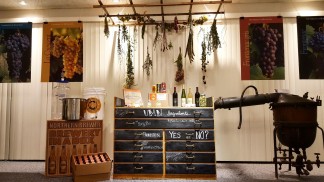by Audrey Simmons
Wangensteen Student Assistant
I am an out-of-state university student here at the U of M who recently turned 21. I was feeling apprehensive about having my first drink in Minnesota until I visited the Wangensteen Historical Library’s exhibit, Bodies and Spirits: The Health & History of Distillation & Fermentation, which runs through May 2016.
I was feeling apprehensive because the state has a rich history surrounding fermented and distilled beverages. Minnesota Public Radio recently announced that there are 111 breweries in Minnesota. With many of these breweries being in the Twin Cities, I was worried about looking like a deer in headlights as I stared at the menus of these establishments. The Bodies and Spirits exhibit helped lessen my anxiety and answer my questions about these beloved beverages.
Exhibit answers questions about alcohol
I had several questions about alcohol. What’s the difference between beer and ale? What exactly is a lager and who had the idea to make it? And is a “hoppier” beer a good thing? After visiting Wangensteen Library’s interactive exhibit, Bodies and Spirits: The Health & History of Fermentation & Distillation, I learned the answers to all of my questions and so much more.
Once you visit this exhibit you can impress the staff at Stub and Herbs by telling them why India Pale Ale (IPA) was first imported and used, or you can order a Hogshead of beer at Blarney’s and watch the waiter’s eyes grow wide when you tell them how many gallons of beer you actually ordered.
If your friends are more into wine than beer you have probably heard them use the excuse, “drinking wine is good for your heart.” I plan on taking my friends who drink wine to this exhibit and showing them the section the library has on wine and fermentation. There they can see where the old saying came from, but they can also see that even doctors in the mid-1800s agreed that too much wine is never a good thing.
Interactive area includes info about local ingredients
The exhibit has several intriguing historical books and illustrations on distillation and fermentation as well as information on the medical uses of essential oils and perfumes, but my favorite part of the exhibit has to be the interactive area that includes local ingredients that go into Minnesota beer and wine.
You can sniff the different types of hopps, see the decoratively hung dried plants that are used by some breweries as ingredients in their drinks, and open drawers to find out interesting facts about local breweries, prohibition, and more.
If you’re turning 21 around the campus area or you’re interested the history of medicinal use of alcohol and other fermented items, I strongly suggest stopping by the Wangensteen library to take a look at the exhibit, Bodies and Spirits: The Health and History of Fermentation and Distillation.
The exhibit is open during regular library hours, 8:00 a.m. – 4:30 p.m. Monday – Friday, or by appointment until May 31st, 2016.





